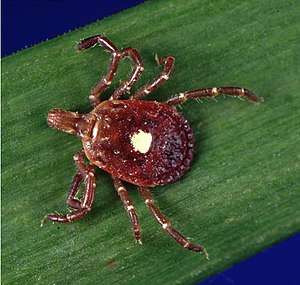Poecilochirus
Poecilochirus is a genus of mites in the family Parasitidae.[1] They feed on fly eggs and larvae. At least 14 species of the genus are carried from one food source to another by beetles of multiple genera in the family Silphidae.
| Poecilochirus | |
|---|---|
 | |
| Poecilochirus carabi | |
| Scientific classification | |
| Kingdom: | |
| Phylum: | |
| Class: | |
| Subclass: | |
| Order: | |
| Family: | |
| Genus: | Poecilochirus G. & R. Canestrini, 1882 |
| Species | |
| |
The probably best studied species are from the Poecilochirus carabi species complex that consists of at least two species, which have specialised on different species of Nicrophorus burying beetles.[2][3][4] The mites' symbiotic relationship with burying beetles is debated. Under certain conditions, the mites appear to protect the beetle's larva or its food supply from fly larvae,[5][6] but the presence of mites on beetle-tended carcasses also reduces male beetle life span and the number of beetle offspring.[7][8][4][9]
Reportedly, some nematodes in the family Allantonematidae are parasites of mites in this genus.[10] Although some species from this genus have been described and sampled on previous real forensic cases or successional studies on carcasses, their usefulness as a forensic marker in forensic entomology has been recently appreciated.[11]
Species
- Poecilochirus armatus (Trägårdh, 1912)
- Poecilochirus austroasiaticus
- Poecilochirus belkahvensis Ramaraju & Madanlar, 1998
- Poecilochirus belovae (Davydova, 1975)
- Poecilochirus britannicus Hyatt, 1986
- Poecilochirus carabi G. Canestrini & R. Canestrini, 1882
- Poecilochirus coimbatorensis Vishnupriya & Mohanasundaram, 1988
- Poecilochirus coleophorae Ramaraju & Mohanasundaram, 1997
- Poecilochirus davydovae Hyatt, 1980
- Poecilochirus donatus Vinnik, 1993
- Poecilochirus hyatti Ramaraju & Madanlar, 1998
- Poecilochirus macgillavryi
- Poecilochirus monospinosus Wise, Hennessey & Axtell, 1988
- Poecilochirus mrciaki Masan, 1999
- Poecilochirus necrophori Vitzthum, 1930
- Poecilochirus pilosula (Banks, 1904)
- Poecilochirus rutellae Ramaraju & Mohanasundaram, 1997
- Poecilochirus serratae Chinniah & Mohanasundaram, 1999
- Poecilochirus sexclavatus Skljar, 2002
- Poecilochirus simplisetae Ramaraju & Madanlar, 1998
- Poecilochirus subterraneus (Muller, 1859)
- Poecilochirus torbaliensis Ramaraju & Madanlar, 1998
References
- Joel Hallan (ed.). "Parasitidae Species Listing". Biology Catalog. Texas A&M University. Retrieved September 4, 2010.
- Brown, Jonathan M.; Wilson, David Sloan (1992). "Local Specialization of Phoretic Mites on Sympatric Carrion Beetle Hosts". Ecology. 73 (2): 463–478. doi:10.2307/1940753. JSTOR 1940753.
- Müller, J K; Schwarz, H H. "Differences in carrier-preference and evidence of reproductive isolation between mites of Poecilochirus carabi (Acari, Parasitidae) living phoretically on two sympatric Necrophorus species (Coleoptera, Silphidae)". Zoologische Jahrbucher, Abteilung Fur Systematik, Okologie und Geographie der Tiere. 117: 23–30.
- Nehring V, Müller JK, Steinmetz N (December 2017). "Phoretic Poecilochirus mites specialize on their burying beetle hosts". Ecology and Evolution. 7 (24): 10743–10751. doi:10.1002/ece3.3591. PMC 5743630. PMID 29299254.
- Backlund, Doug (1994). "American Burying Beetle". South Dakota Department of Game, Fish and Parks, Division of Wildlife. Archived from the original on 2008-04-30. Retrieved 2008-07-21.
- "Decomposition: Mites". Australian Museum. 2003. Archived from the original on 2008-06-27. Retrieved 2008-07-21.
- Wilson, David Sloan; Knollenberg, W. G. (April 1987). "Adaptive indirect effects: the fitness of burying beetles with and without their phoretic mites". Evolutionary Ecology. 1 (2): 139–159. doi:10.1007/bf02067397. ISSN 0269-7653.
- De Gasperin O, Kilner RM (December 2015). "Friend or foe: inter-specific interactions and conflicts of interest within the family". Ecological Entomology. 40 (6): 787–795. doi:10.1111/een.12259. PMC 4678582. PMID 26681822.
- De Gasperin O, Kilner RM (2016-03-17). "Interspecific Interactions and the Scope for Parent-Offspring Conflict: High Mite Density Temporarily Changes the Trade-Off between Offspring Size and Number in the Burying Beetle, Nicrophorus vespilloides". PLOS One. 11 (3): e0150969. doi:10.1371/journal.pone.0150969. PMC 4795767. PMID 26985819.
- Capinera, John L., ed. (2008). Encyclopedia of Entomology. Springer reference (2nd ed.). Dordrecht; London: Springer. p. 756. ISBN 978-1-4020-6242-1. OCLC 156813127. Retrieved 23 July 2009.
- González Medina A, González Herrera L, Perotti MA, Jiménez Ríos G (March 2013). "Occurrence of Poecilochirus austroasiaticus (Acari: Parasitidae) in forensic autopsies and its application on postmortem interval estimation". Experimental & Applied Acarology. 59 (3): 297–305. doi:10.1007/s10493-012-9606-1. PMID 22914911.
